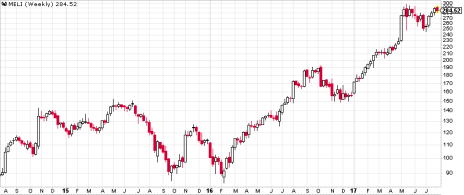In my three previous articles on emerging market stocks to buy (to read them, click here), I stuck to the Chinese stocks that dominate investors’ attention in the world of emerging market stocks that trade on U.S. exchanges. As with the other stock in this series, I’m using comparisons with familiar U.S. stocks to lobby for investment in ones from the emerging world.
China, while it’s the biggest game in town for growth investors, isn’t the only one. Today, I want to turn to a South American company that’s growing rapidly as access to the internet spreads across South and Central America.
Like eBay (EBAY)? Consider MercadoLibre (MELI)
eBay (EBAY) was a hot item and a household word in the early days of the century, fascinating internet users with a bewildering array of goods offered in online auctions. The company booked double-digit revenue and earnings growth from 2002 to 2008, when the Great Recession knocked its pins out from under it. The stock recovered strongly from its low at 4 in early 2009, soaring to 24 at the end of 2012. Unfortunately, EBAY was still trading at 24 three-and-a-half years later in the middle of 2016. That’s when it caught another updraft and started acting like a growth stock again.
EBAY has advanced from 30 to 36 since 2017 began, following through on the monster rally from July 2016 that reignited investors’ interest.




eBay learned over the years that its business wasn’t just online auctions, it was providing an online marketplace where all kinds of business could be transacted. The company’s Marketplace, StubHub and Classifieds platforms connect buyers and sellers around the world, with eBay providing secure payment technologies, verification of buyers’ and sellers’ identities and reputations, comparison shopping and buyer-protection policies. By providing a safe place for sellers to offer goods and services and buyers to shop for them, eBay let the entrepreneurial spirit do the heavy lifting.
The problem with eBay is that its best growth days are behind it. Revenue declined by 45% in 2014 and fell 2% in 2015. Growth returned in 2016, but revenue rose just 5%, and has increased just 4% in each of the first two quarters of 2017.
The company doesn’t pay a dividend to stockholders, so what you have is a stock whose earnings per share are forecast to increase just 6% in 2017 and 10% in 2018. It trades at a 19 P/E, which isn’t bad, but isn’t really a bargain either. And institutional sponsorship, which peaked at 541 million shares in Q3 2016 is down to 487 million.
Why MELI Is One of the Best Emerging Market Stocks to Buy
MercadoLibre (MELI) (the name means “free market” in Spanish) is very much the child of eBay; eBay owns an 18% stake in MercadoLibre and actively aided the company’s development. The company was founded in 1999 in Argentina, but operates its online marketplace across most of Central and South America. In fact, the countries that MercadoLibre covers represent 98% of the GDP of Latin America.
The company’s services include a secure payment system (MercadoPago), an advertising program, a Webstores program to help merchants set up their shops and a shipping service (MercadoEnvios).
MercadoLibre has grown strongly as increasing internet penetration grows its target audience via mobile devices. Revenue grew by 30% in 2016 (up from 17% in 2015) and 74% in the company’s Q1 quarterly report. Earnings are forecast to increase by 34% in 2017 and 35% in 2018.
MELI has soared from 159 as 2017 began to over 290 in recent trading, which follows its run from 88 in February 2016.
MELI hasn’t been an easy stock to hold for the long term. The stock corrected strongly in the last three months of 2016 and dipped again in May and June 2017. If you want to own it, you need to pick your buy points carefully and keep your sell disciplines sharp.
But if you’re willing to do those things—which are, after all, the essence of what growth investing is all about—MELI has the horses to be a rewarding investment.
I’ve had MELI in the portfolio of Cabot Global Stocks Explorer four times in the past, and may recommend it again if it can break out above the old highs at 298 that it etched in May. But it’s a good illustration of the raw power that emerging market stocks offer to those with a higher tolerance for risk than the average index investor. If that sounds like a good idea to you, and you want to find more emerging market stocks to buy, you can learn more by clicking here.
Editor’s note:
To view the first stock recommended in the series, click here.
To view the second stock recommended in the series, click here.
To view the third stock recommended in the series, click here.





